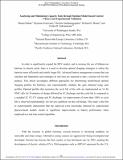Analyzing and minimizing capacity fade through optimal model-based control: theory and experimental validation
Author(s)
Pathak, Manan; Sonawane, Dayaram; Santhanagopalan, Shriram; Braatz, Richard D; Subramanian, Venkat R.
DownloadPublished version (819.9Kb)
Alternative title
(Invited) Analyzing and minimizing capacity fade through optimal model-based control: theory and experimental validation
Terms of use
Metadata
Show full item recordAbstract
In order to significantly expand the BEV market, and to increase the use of lithium-ion batteries in electric grids, there is a need to develop optimal charging strategies to utilize the batteries more efficiently and enable longer life. Advanced battery management systems that can calculate and implement such strategies in real time are expected to play a critical role for this purpose. This article investigates different approaches for determining model-based optimal charging profiles for batteries, and experimentally validates the gain obtained using such profiles. Optimal profiles that maximize the cycle life of the cells are implemented on 16 Ah NMC cells for 30 minutes of charge followed by 5C discharge, and the cycle life is compared to a standard 2C CC-CV charge and 5C discharge. An improvement of more than 100%in cycle life is observed experimentally, for our test conditions on this cell design. This study is the first to experimentally demonstrate that the improved extra knowledge obtained by sophisticated physics-based models results in significant improvements in battery performance when employed in a real time control algorithm. ©2016 Paper delivered at the 230th ECS Meeting/PRIME 2016, October 2, 2016-October 7, 2016, Honolulu, Hawaii
Date issued
2016Department
Massachusetts Institute of Technology. Department of Chemical EngineeringJournal
ECS transactions
Publisher
The Electrochemical Society
Citation
Pathak, Manan, et al., "Analyzing and minimizing capacity fade through optimal model-based control: theory and experimental validation." ECS transactions 75 (2016): no. 23 doi 10.1149/07523.0051ECST ©2016 Author(s)
Version: Final published version
ISSN
1938-6737
1938-5862